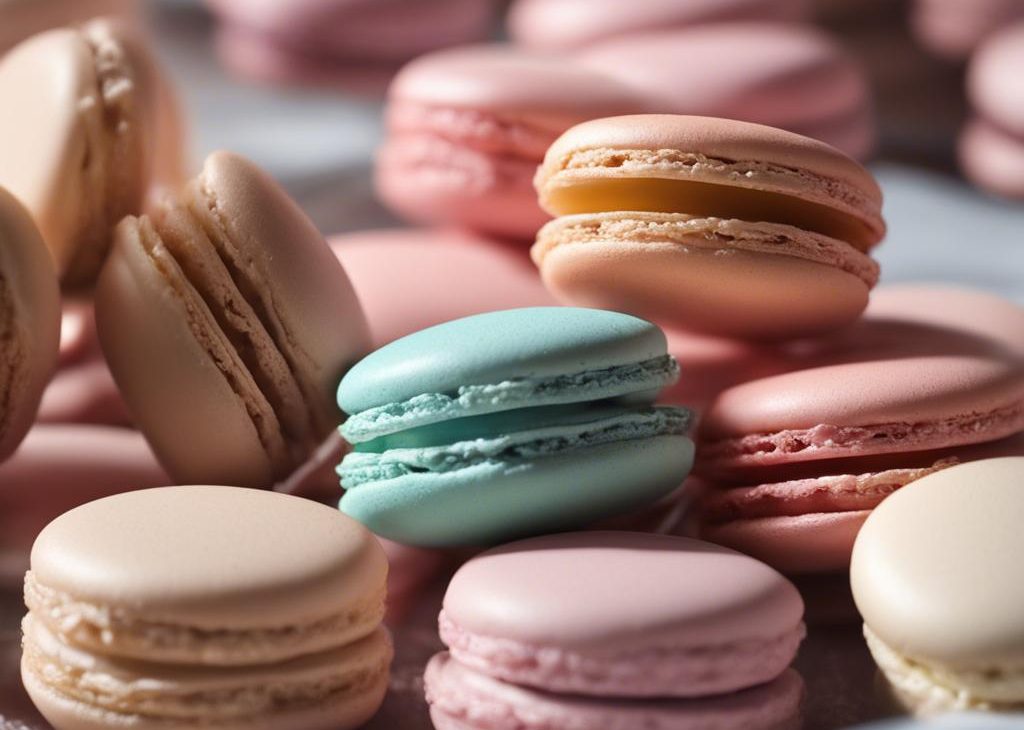


French macarons are delicate cookies with a crunchy exterior and weightless interior. If there’s one thing to know before beginning French macarons at home, it’s this: these cookies are not simple. Impossible? Absolutely not. Requiring BOTH patience and practice? Yes.
That’s why they’re so expensive in bakeries and restaurants! These are quite particular little cookies, as I’m sure you already guessed. I’m not saying this to intimidate you– I’m saying this to prepare you for a French macaron journey. Let’s get started. You can do it.
Before you read more about this particular recipe, I want to mention that I have an updated and more reliable recipe for French macarons published. In the newer recipe, I have an additional 6 years of practice and am much more confident with the consistency of results. Feel free to try these, but I like my newer French macarons recipe better..
A kitchen scale is required for the best results. I’m actually encouraging you to NOT use US cup measurements for this recipe, as there is way too much room for error. Whenever I made macarons based off of cup measurements (2/3 cup this; 3/4 cup that), I messed up the cookies every single time. They tasted “fine” but not authentic. And they didn’t look very pretty, either.
The base ingredients for these French macaron cookies are almond flour, confectioners’ sugar, and room temperature egg whites. You can make your own almond flour at home by pulsing blanched, skinless, unsalted, raw almonds until fine. However, buying a package is easier and you get the super-fine texture needed for macaron batter. I like Bob’s Red Mill brand. I find this in my regular grocery store in the baking aisle.
Almond flour and confectioners’ sugar is blended together in a food processor or blender until thoroughly combined and fine in texture. Like this:
Then beat 3 room temperature egg whites until stiff peaks form. Make sure the egg whites are at room temperature. In fact, separate the egg whites in advance. Then, let them sit out for a few hours or even overnight. They need to “age.”
Left: Stiff peaks. Right: sifted granulated sugar. Sifted being the key word here. The last thing you want are coarse granules of sugar in your airy, light macaron cookies.
Lightly beat the sifted sugar into the egg whites then fold in the almond flour/confectioners’ sugar blend. Slow slow slow folds. Always be gentle with macaron batter.
The batter will be thick, off-white, glossy, and sticky.
Now it’s time to pipe the batter onto baking sheets.
I tested macarons on parchment paper, bare non-stick sheets, and silicone baking mats. Silicone baking mats were BY FAR the easiest surface to work with. I found the macarons spread a little more on the bare non-stick sheet surface, as well as the parchment paper. Using either surface also made it a little more difficult to remove the delicate cookies.
The macaron batter is piped onto baking sheets. It took me a lot of practice to get those perfect little circles and, trust me, each one still isn’t perfect. You will need a pastry bag fitted with a round tip—I usually use Ateco 806 (size 6) 1/2″ plain tip.
Pipe small rounds. The macaron batter will slightly spread, so start with only a little bit. You want the rounds to be around 1.5 inches in diameter.
Before baking, let the piped rounds sit. Just as you let the egg whites come to room temperature, the batter rounds need time to “age” as well. This is crucial to making macarons. Time is macaron batter’s best friend. During this time, the air will will help the rounds set and form a dry shell. Meaning, they will no longer be wet and sticky, which helps the cookies rise up and create those familiar ruffled feet at the bottoms. I always let mine sit for at least 45 minutes.
Then, bake the cookies:
The cookies take around 10 minutes in the oven. The tops will be crisp, the bottoms will develop their trademark crinkly feet.
Allow them to cool, then fill with your favorite fillings/frostings.
Here I use my basic vanilla frosting. You can tint the frosting any color you like OR you can use other fillings. I list several in the recipe notes below, so there’s plenty to choose from.
Be sure to read through all of the recipe instructions before you begin so you know the what, when, where, and why’s of the recipe. Also, read my Quick Tips for Success below. You’re guaranteed better success doing both.
You can also try these Salted Caramel Cinnamon Macarons:
Dust your piped macaron shells (before drying in step 7) with ground cinnamon. Fill your macarons with salted caramel buttercream. For the buttercream, you need 1/2 cup (115g) softened unsalted butter, 1 and 1/2 cups (180g) confectioners’ sugar, 1 teaspoon pure vanilla extract, and 1/3 cup (80ml) store-bought or homemade salted caramel. To make the buttercream: In a medium bowl using a hand-held or stand mixer fitted with a paddle or whisk attachment, beat the butter for 1 minute on high speed until completely smooth and creamy. Beat in the confectioners’ sugar until combined and creamy, then beat in the vanilla extract. Gently fold in the salted caramel until mostly combined.
For best results, use a scale to measure these ingredients in grams